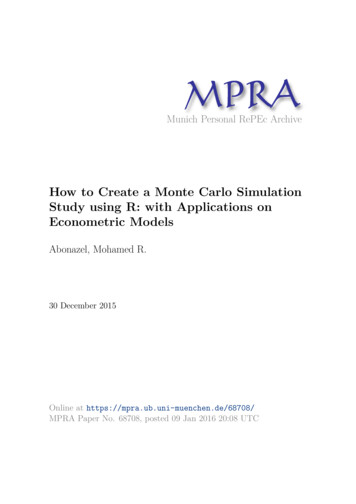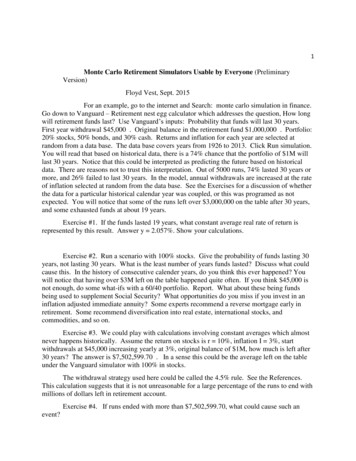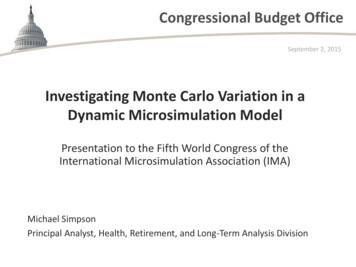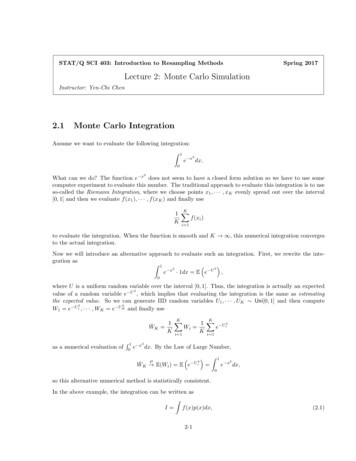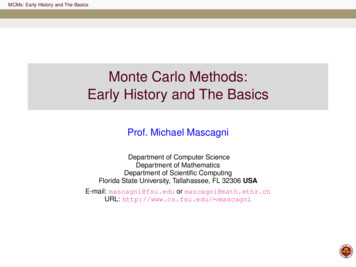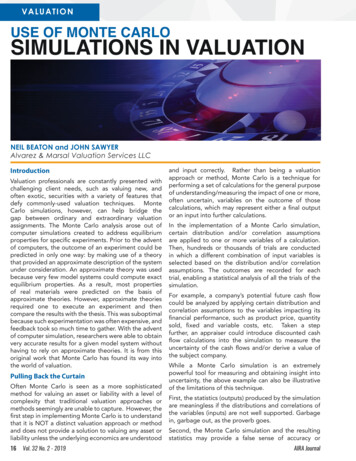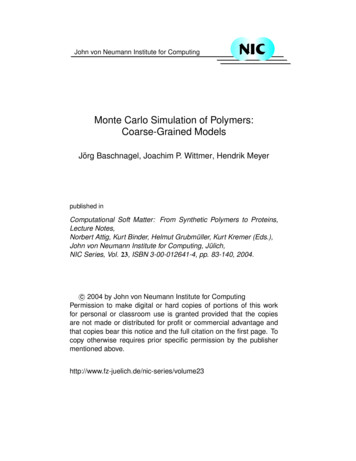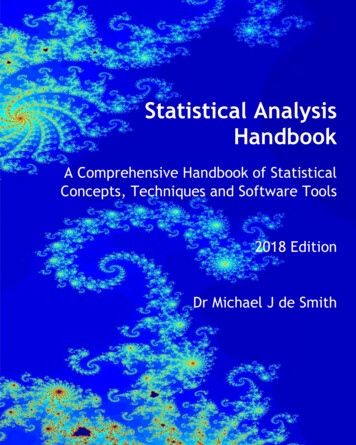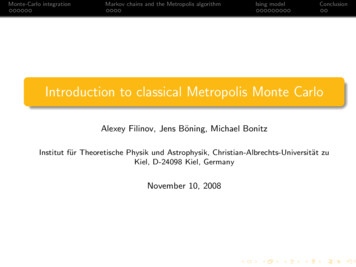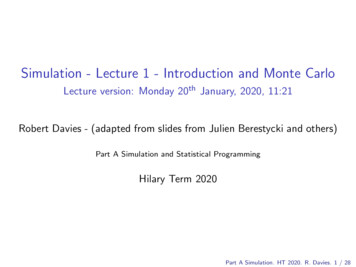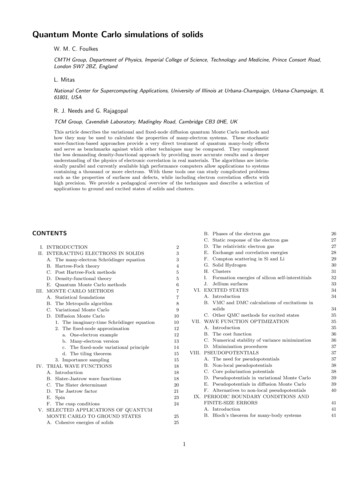
Transcription
Quantum Monte Carlo simulations of solidsW. M. C. FoulkesCMTH Group, Department of Physics, Imperial College of Science, Technology and Medicine, Prince Consort Road,London SW7 2BZ, EnglandL. MitasNational Center for Supercomputing Applications, University of Illinois at Urbana-Champaign, Urbana-Champaign, IL61801, USAR. J. Needs and G. RajagopalTCM Group, Cavendish Laboratory, Madingley Road, Cambridge CB3 0HE, UKThis article describes the variational and fixed-node diffusion quantum Monte Carlo methods andhow they may be used to calculate the properties of many-electron systems. These stochasticwave-function-based approaches provide a very direct treatment of quantum many-body effectsand serve as benchmarks against which other techniques may be compared. They complementthe less demanding density-functional approach by providing more accurate results and a deeperunderstanding of the physics of electronic correlation in real materials. The algorithms are intrinsically parallel and currently available high performance computers allow applications to systemscontaining a thousand or more electrons. With these tools one can study complicated problemssuch as the properties of surfaces and defects, while including electron correlation effects withhigh precision. We provide a pedagogical overview of the techniques and describe a selection ofapplications to ground and excited states of solids and clusters.CONTENTSI. INTRODUCTIONII. INTERACTING ELECTRONS IN SOLIDSA. The many-electron Schrödinger equationB. Hartree-Fock theoryC. Post Hartree-Fock methodsD. Density-functional theoryE. Quantum Monte Carlo methodsIII. MONTE CARLO METHODSA. Statistical foundationsB. The Metropolis algorithmC. Variational Monte CarloD. Diffusion Monte Carlo1. The imaginary-time Schrödinger equation2. The fixed-node approximationa. One-electron exampleb. Many-electron versionc. The fixed-node variational principled. The tiling theorem3. Importance samplingIV. TRIAL WAVE FUNCTIONSA. IntroductionB. Slater-Jastrow wave functionsC. The Slater determinantD. The Jastrow factorE. SpinF. The cusp conditionsV. SELECTED APPLICATIONS OF QUANTUMMONTE CARLO TO GROUND STATESA. Cohesive energies of VII.VIII.IX.25251B. Phases of the electron gasC. Static response of the electron gasD. The relativistic electron gasE. Exchange and correlation energiesF. Compton scattering in Si and LiG. Solid HydrogenH. ClustersI. Formation energies of silicon self-interstitialsJ. Jellium surfacesEXCITED STATESA. IntroductionB. VMC and DMC calculations of excitations insolidsC. Other QMC methods for excited statesWAVE FUNCTION OPTIMIZATIONA. IntroductionB. The cost functionC. Numerical stability of variance minimizationD. Minimization proceduresPSEUDOPOTENTIALSA. The need for pseudopotentialsB. Non-local pseudopotentialsC. Core polarization potentialsD. Pseudopotentials in variational Monte CarloE. Pseudopotentials in diffusion Monte CarloF. Alternatives to non-local pseudopotentialsPERIODIC BOUNDARY CONDITIONS ANDFINITE-SIZE ERRORSA. IntroductionB. Bloch’s theorem for many-body 8393940414141
C. Periodic boundary conditions and CoulombinteractionsD. Coping with finite-size errors1. Introduction2. Finite-size correction and extrapolationformulae3. Choosing the simulation-cell wave vector4. Interaction energy finite-size effectsX. COMPUTATIONAL ISSUESA. Representation of the single-particle orbitalsB. Evaluation of the trial wave functionC. Evaluation of the local energyD. Efficient treatment of the Coulomb interactionE. Scaling with the number of particlesF. QMC on Parallel ComputersXI. CONCLUSIONSACKNOWLEDGMENTSReferencesthe trial wave function. The other method we consider,diffusion Monte Carlo (DMC), overcomes this limitationby using a projection technique to enhance the groundstate component of a starting trial wave function. During the last ten years it has become clear that VMC andDMC can produce very accurate ground-state expectation values for weakly correlated solids. They can alsoprovide some information about specific excited states,although not yet full excitation spectra.Although VMC and DMC are the only methods currently used to study realistic continuum models of electrons in solids, other methods are useful in other systems.Auxiliary-field Monte Carlo (for a recent review see Senatore and March, 1994) is often applied to model Hamiltonians such as the Hubbard model, and path-integralMonte Carlo (reviewed by Ceperley, 1995a, 1995b) is themain QMC method used to study bosonic systems suchas liquid helium. Both auxiliary-field and path-integralQMC are in principle capable of simulating interactingelectrons at finite temperature and may one day be usedto study real solids. In this review, however, we focus onthe two techniques that have already proved their worthin solids: the zero-temperature VMC and DMC methods.Because VMC and DMC simulations are very expensive, most calculations of the ground-state properties ofsolids use less accurate methods based on HohenbergKohn-Sham density-functional theory (DFT) or HartreeFock (HF) theory (see, e.g., Parr and Yang, 1989). Theefficiency of these techniques arises from the replacementof the electron-electron Coulomb interactions by an effective one-electron potential; this makes the many-electronSchrödinger equation separable and hence much easierto solve. DFT, in particular, has been remarkably successful and is now used in fields ranging from solid statephysics and quantum chemistry to geophysics and molecular biology.Although DFT is exact in principle, it relies in practiceon approximations to the unknown exchange-correlationenergy functional, which accounts for the complicatedcorrelated motion of the electrons. Most DFT calculations use either the local density approximation or thegeneralized gradient approximation, both of which worksurprisingly well under most circumstances. Obvious failures are uncommon, but include the underestimation ofs to d transfer energies in transition metal atoms anddifficulties in describing van der Waals bonding, both ofwhich have been dealt with successfully using QMC techniques. Problems also occur in covalent sp-bonded materials, as demonstrated by the QMC studies of carbonclusters described in Sec. V. The unreliability of the DFTresults for these clusters provides a good demonstrationof the limited predictive power of existing approximateexchange-correlation energy functionals.The strong electronic correlations in solids containingd and f electrons produce a wide range of subtle effects,42434343444445454646474747485050I. INTRODUCTIONThe past few decades have seen dramatic improvements in our ability to simulate complicated physicalsystems using computers. This has led to the conceptof computer simulation as a “third way” of doing science, closer to experiment than theory but complementary to both. Like experiments, simulations produce datarather than theories and should be judged on the qualityof those data. We aim to show that the quantum MonteCarlo (QMC) methods described in this review are accurate and reliable, and that the data and insights theyprovide are often difficult or impossible to obtain in anyother way.In studying the quantum mechanical properties ofsolids we are fortunate that the underlying physical lawshave been known for over 70 years. The difficulty arisesfrom the complexity of the equations which, as Dirac(1929) famously wrote, are “much too complicated to besoluble”. It hardly seems possible that one could solvethe 3N -dimensional Schrödinger equation that describesthe N interacting electrons in a solid, but this is exactlywhat QMC methods allow us to do. With current parallel computers we can simulate periodic systems containing up to a thousand or so electrons, which is enoughto model many properties of solids with impressive accuracy. QMC is now recognized as a valuable tool forcalculating the physical properties of real materials.The term “quantum Monte Carlo” covers several different techniques based on random sampling. The simplestof these, variational Monte Carlo (VMC), uses a stochastic integration method to evaluate expectation values fora chosen trial wave function. In a system of 1000 electrons the required integrals are 3000 dimensional, andfor such problems Monte Carlo integration is much moreefficient than conventional quadrature methods such asSimpson’s rule. The main drawback of VMC is that theaccuracy of the result depends entirely on the accuracy of2
and Nightingale and Umrigar (1999).In Sec. II we give an overview of techniques used tostudy the quantum mechanics of many-electron systems.Section III discusses the statistical foundations of theMonte Carlo approach and describes the theory behindthe VMC and DMC methods. The successes of VMC andDMC rest on the surprising accuracy of relatively simpletrial wave functions, which are considered in Sec. IV. InSec. V we describe a selection of QMC simulations of theground-state properties of solids and clusters, while inSec. VI we highlight studies of excited states. In Sec. VIIwe describe the methods used to optimize trial wave functions, and in Sec. VIII we discuss pseudopotentials andwhy they are needed in QMC simulations. Section IXlooks at the issue of periodic boundary conditions andthe proper treatment of finite-size errors. In Sec. X weconsider issues of computational efficiency. Section XIconcludes this review.including the anomalous normal-state transport properties of high-temperature superconductors and the verylarge low temperature specific heat coefficients of heavyfermion materials. Correlation effects such as these arenot well described by DFT or HF and are normally studied using simplified Hamiltonians such as the Hubbardmodel. Given a set of atomic positions, it is often possibleto devise a model Hamiltonian that gives an excellent account of the low-lying electronic excitations on an energyscale that may be as low as a few degrees Kelvin. Thesimplicity is not achieved without cost, however, sincemost model Hamiltonians drastically approximate the“independent-electron” energy given so accurately by HFand DFT calculations. The independent-electron contribution is normally more than 99% of the total energy, andso model Hamiltonians rarely give accurate ground-stateenergies as functions of the atomic positions. This reviewis concerned with studies of interatomic forces and chemical bonding, for which the relevant energy scales rangefrom a few meV to several eV, and for which continuumapproaches based on the full many-electron Schrödingerequation are more appropriate.Continuum QMC simulations require much more computer time than DFT or HF calculations, but can alreadyachieve chemical accuracy (usually defined as 1 kcal permole, which is about 0.04 eV per molecule) in small systems and may soon achieve it in solids. Chemical accuracy is sufficient to address most issues involving interatomic forces and chemical reactions, but is still an orderof magnitude worse than the accuracy required to studyphenomena such as superconductivity. The computational cost of a QMC calculation increases as the cubeof the number of electrons, which makes applications tolarge systems feasible, and there is no fundamental reason why the accuracy should fall off for large systems.QMC algorithms are also quite simple to program andvery well suited to massively parallel computation.QMC methods have already proved themselves important in a very broad sense — they can provide muchmore than just accurate numbers. A good example isprovided by Ceperley and Alder’s (1980) simulations ofthe homogeneous electron gas, which underlie the accurate parameterized local density approximations used inmost density-functional calculations. The rapid acceptance of these QMC-based approximations helped sparkthe twenty years of growth and development that madedensity-functional methods so popular and powerful.Our intention is that most of what follows should beaccessible to a wide audience, but no doubt some readerswill find it helpful to consult other sources. Kalos andWhitlock (1986) give a straightforward introduction toMonte Carlo methods in general, and Hammond, Lester,and Reynolds (1994) cover the use of QMC in quantumchemistry. Other useful recent sources are the review byAnderson (1999) and the books edited by Lester (1997)II. INTERACTING ELECTRONS IN SOLIDSA. The many-electron Schrödinger equationOne of the great challenges of condensed matterphysics is to obtain accurate approximate solutions ofthe many-electron Schrödinger equation. Because themass of an electron is so small compared to that of anucleus (me /M 10 3 10 5 ), the dynamics of electrons and nuclei in solids can, to a good approximation,be decoupled. Within the Born-Oppenheimer approximation, the many-electron wave function and energy maythen obtained by solving a time-independent Schrödingerequation in which the nuclear positions are consideredfixed. The non-relativistic Born-Oppenheimer Hamiltonian takes the form,1 X 2 XXZα i 2 i ri dα αi1 XX1 ,2 i ri rj Ĥ (2.1)j6 iwhere ri are the electron positions, dα are the nuclearpositions, and Zα are the nuclear charges. The first quantum mechanical studies of chemicallybonded systems appeared soon after the birth of quantum mechanics. Heitler and London (1927) calculatedthe binding energy and internuclear separation of H2 byapproximating the wave function as an antisymmetrizedproduct of atomic 1s functions centered on the two nuclei. A different approach was taken by Hartree (1928), We use Hartree atomic units, e me h̄ 4π 0 1, forall equations.3
wave function must be antisymmetric under particle exchange, so thatFock (1930), and Slater (1930), who argued that it is reasonable to replace the intractable system of interactingelectrons by one involving independent electrons moving in a self-consistent field. Coulson and Fischer (1949)showed that the Heitler-London and Hartree-Fock (HF)wave functions were exact in the limiting cases of strongelectron correlation and weak electron correlation, respectively, and that the truth lay somewhere in between.It turns out that many chemically bonded systems areweakly correlated, so that the HF approach is normallya good starting point. This point of view underlies themolecular orbital theory developed by Hund (1928), Mulliken (1928), Hückel (1931a, 1931b, 1932), and others.Calculating the electronic structure of solids poses aformidable challenge because of the large number of particles involved. The first steps were taken by Sommerfeldand others, who made the bold proposal that in metalsthe forces on the electrons due to the ions approximatelycancel the forces due to the other electrons (Sommerfeld and Bethe, 1933), leading to the free-electron model.The work of Bloch (1928) added the important conceptsof Bloch waves and energy bands. It was soon realized,however, that HF theory fails to give a proper description of metals, and hence that correlation effects have tobe included from the outset.The most important and widely used electronic structure method currently applied to solids is based on themany-electron density-functional theory (DFT) developed by Hohenberg and Kohn (1964) and Kohn andSham (1965). This approach reduces the complicatedmany-electron problem to an independent electron problem with an effective one-electron potential that dependson the electron density. Although at first glance it appears that DFT must be an approximate method, it is inprinciple capable of describing electron correlation effectsexactly. DFT has been the main tool used to study theelectronic structure of solids for more than two decades(Jones and Gunnarsson, 1989; Parr and Yang, 1989; Dreizler and Gross, 1990), and over the last decade has alsobecome popular in quantum chemistry.The HF and DFT methods are very relevant to our discussion of QMC. The QMC techniques we focus on hererely on the availability of reasonable approximations tothe many-electron wave function, which are often constructed using one-electron orbitals obtained from HF orDFT calculations. A brief introduction to these methodsand to correlated wave function methods is given in thefollowing subsections. Many of the concepts and equations will be referred to later in the article.Ψ(. . . , xi , . . . , xj , . . . , ) Ψ(. . . , xj , . . . , xi , . . . , ) ,(2.2)where xi {ri , σi } represents the space and spin coordinates of an electron. The antisymmetry ensures that notwo electrons can have the same set of quantum numbersand that the Pauli exclusion principle is satisfied. Thesimplest wave function with the required antisymmetryis a Slater determinant,ψ1 (x1 ) ψ1 (x2 )ψ2 (x1 ) ψ2 (x2 )D(X) .ψN (x1 ) ψN (x2 ).ψ1 (xN )ψ2 (xN ).ψN (xN ),(2.3)where X (x1 , x2 , . . . , xN ) is shorthand for the list of allthe electron coordinates. In most cases the single-particleorbitals are assumed to be products of spatial and spinfactors,ψi (xj ) ψi (rj )δσi ,σj ,(2.4)where δσi ,σj 1 if σj σi and zero otherwise. If thedeterminant contains N orbitals with σi and N N N with σi , it is an eigenfunction of Ŝz witheigenvalue (N N )/2.The exact ground state wave function of an interacting system cannot be represented as a single Slater determinant, but a Slater determinant can nevertheless beused as a variational trial function. If this trial functionis optimized by minimizing the expectation value of Ĥwith respect to the orbitals ψi (r), one obtains the selfconsistent HF equations, 1 2 i ψi (r) Vion (r) ψi (r)2XZ ψj (r0 ) 2 dr0ψi (r) r r0 jZXψj (r0 )ψi (r0 ) δσi σj dr0ψj (r) ,(2.5) r r0 jwhere the Lagrange multipliers i arise from the orthonormality constraints on the single-particle orbitals.The ionic potential isX Zα,(2.6)Vion (r) r dα αas in Eq. (2.1), while the other two terms, known asthe Hartree and exchange terms, describe the electronelectron interactions. The effect of the exchange term isto keep electrons of like spin apart and, as a result, eachelectron has around it a Fermi or exchange hole containing unit positive charge.B. Hartree-Fock theoryThe HF approximation (Fock, 1930; Slater, 1930) is thesimplest theory that correctly incorporates the permutation symmetry of the wave function. The many-electron4
approximated and the method is non-variational. CCmethods are capable of yielding highly accurate resultsand are direct competitors of QMC methods for molecular calculations, but they are very expensive in large systems. For example, the computational cost of a CCSDcalculation (coupled cluster with single and double excitations) scales as N 6 . HF and post HF methods aredescribed in a straightforward manner in the book bySzabo and Ostlund (1989).C. Post Hartree-Fock methodsThe single-determinant HF theory includes the exchange effects arising from the antisymmetry of themany-electron wave function, but neglects the electroniccorrelations caused by the electron-electron Coulomb repulsion. Correlation energies are a small fraction ofthe total energy, but they can be very important. Forexample, the correlation energy of a nitrogen moleculeamounts to only 0.5% of the total electronic energy, butaccounts for nearly 50% of the molecular binding energy.Correlation can be included by using a linear combination of determinants in a post Hartree-Fock method.However, the central problem with such expansions isthat very large numbers of determinants are needed todescribe many-electron wave functions accurately. Thereare two reasons for this poor convergence. The first,which applies equally in small and large systems, is thatmany determinants are needed to describe the cusp-likegradient discontinuities that occur whenever two electrons have the same position (see Sec. IV). The second isthat the required number of determinants increases veryrapidly with the system size.In a full configuration interaction calculation one includes all the determinants that can be formed from themolecular orbitals calculated with a particular basis set.Consider, for example, a system of N electrons occupyingstates chosen from a set of 2N molecular orbitals. Thetotal number of N -electron Slater determinants isD. Density-functional theoryComputational methods based on DFT are now themost popular approach for calculating the electronicproperties of solids and large molecules. DFT is a formally exact theory based on a theorem of Hohenberg andKohn (1964), which states that the ground state properties of a many-electron system may be obtained by minimizing a functional E[n(r)] of the electron number density n(r). The minimum value of the functional is theexact ground state energy, and the minimum is attainedwhen n(r) is the exact ground state density.Kohn and Sham (1965) introduced the idea of an auxiliary non-interacting system with the same electron density as the real system. This enabled them to expressthe electron density of the interacting system in termsof the one-electron wave functions of the non-interactingsystem,e2N ln 2N(2N )! 2N ln N e2N ln 2 ,(2.7)N !N !efor large N . The number of determinants therefore risesexponentially with N . The full configuration interactionapproach in conjunction with a good basis set can onlybe applied to small systems and the current practicallimit for highly accurate calculations is reached for smallmolecules such as H2 O.One way of reducing the computational cost is to include only the most important determinants. This is normally done by considering low energy excitations from areference determinant, which is normally the HF groundstate. For example, if single and double excitations areincluded we have the configuration interaction singlesand doubles method, for which the computational costscales as N 6 . Unfortunately, such truncated configuration interaction methods are not size consistent; that is,the energy does not scale linearly with the number of electrons. For example, in a configuration interaction singlesand doubles calculation for N widely separated hydrogen molecules the correlation energy increases only as N.Such a method is clearly unsuitable for applications tosolids. The size consistency problem can be overcome viacoupled cluster (CC) expansions (Čı́žek, 1969). Theseimplicitly include all excitations from the reference determinant, although the coefficients in the expansion aren(r) NXi 1 ψi (r) 2 ,(2.8)and to write the Hohenberg-Kohn energy functional inthe form,ZN Z1XE [n(r)] ψi (r) 2 ψi (r)dr n(r)Vion (r)dr2 i 1Z Z1n(r)n(r0 ) drdr0 Exc [n(r)] , (2.9)2 r r0 where the terms on the right hand side are the kinetic energy of the non-interacting system with electron densityn(r), the energy of interaction with the ionic potential,the Hartree energy, and the exchange-correlation (XC)energy. Equation (2.9) may be taken as the definition ofthe XC energy functional Exc [n(r)], which is not knownexactly and has to be approximated.By minimizing the total energy functional of Eq. (2.9),Kohn and Sham showed that one could calculate theground state ψi , and hence the ground state number density and energy, by solving the self-consistent set of equations, 1 2 Vion (r) VH (r) Vxc (r) ψi (r) i ψi (r) ,2(2.10)5
where the Hartree potential isZn(r0 )VH (r) dr0, r r0 Monte Carlo (VMC) and fixed-node diffusion quantumMonte Carlo (DMC). Like all QMC methods, these areclosely related to Monte Carlo methods used in classicalstatistical mechanics (Nightingale, 1999). In the VMCmethod expectation values are calculated via MonteCarlo integration over the 3N -dimensional space of electron coordinates. The more sophisticated DMC methodis a projector approach in which a stochastic imaginarytime evolution is used to improve a starting trial wavefunction.Other Monte Carlo methods, such as auxiliary-fieldQMC (reviewed by Senatore and March, 1994) and pathintegral QMC (reviewed by Ceperley, 1995a, 1995b), mayalso be used to study interacting many-electron systems.Recent progress along these lines includes the development of the shifted-contour auxiliary field method (Baer,Head-Gordon and Neuhauser, 1998; Baer and Neuhauser,2000), which has already been applied to small molecules,and the introduction of the reptation QMC method (Baroni and Moroni, 1999), which is an interesting hybrid ofpath-integral and diffusion QMC. The more establishedrestricted path-integral fermion Monte Carlo method(Ceperley, 1995b) has been used to investigate the formation of a gas of molecular hydrogen from a neutral systemof electrons and protons at high temperature (Magro etal., 1996), and to calculate the forces between protons inan electron gas (Zong and Ceperley, 1998). Unlike VMCand DMC, which are zero temperature methods in whichone considers a single wave function, path-integral andauxiliary-field QMC may both be used to compute expectation values at finite temperature. These methodshave not yet been applied to real solids, however, and weshall not discuss them further in this review. We alsorestrict ourselves to continuum models and choose notto consider lattice models such as the Hubbard model.Although the methods described in this article may beapplied to lattice problems, other QMC methods such asthe auxiliary field approach are also useful in such systems (Blankenbecler, Scalapino, and Sugar, 1981).McMillan (1965) was the first to use the VMC methodin his study of liquid 4 He. One of the first applicationsto a many-fermion system was by Ceperley, Chester, andKalos (1977). A very early calculation by Donsker andKac (1950) employed a type of projector Monte Carlomethod, but their algorithm was inefficient and failsfor unbounded potentials such as the Coulomb interaction. Kalos (1962, 1967) developed the projector GreenFunction Monte Carlo method and enormously improvedits efficiency by introducing the concept of importancesampling, in which a trial or guiding wave function isused to steer the Monte Carlo moves (Kalos, Levesqueand Verlet, 1974). The DMC algorithm (Grimm andStorer, 1971; Anderson, 1975, 1976) discussed here maybe viewed as an accurate and convenient approximationto the full Green Function Monte Carlo algorithm, and(2.11)and the XC potential isVxc (r) δExc [n(r)].δn(r)(2.12)The best known approximation for Exc [n(r)] is the local density approximation (LDA),ZLDAExc[n(r)] hom(2.13)xc (n(r)) n(r) dr ,where homxc (n) is the XC energy per electron in a uniformelectron gas of density n. The non-uniform electron gasat r is therefore treated as if it was part of a uniformelectron gas of constant density n n(r). This approximation is obviously accurate when the electron densityis almost uniform, but also works surprisingly well whenthe distribution of electrons is strongly inhomogeneous,such as at surfaces and in molecules. The analogous approximation for spin-polarized systems, which is knownas the local spin-density approximation (LSDA), has alsoproved very successful. The LDA and LSDA were usedthroughout the development of DFT and are still widelyused in studies of solids.In cases when the LDA is not accurate enough it seemssensible to try approximating Exc [n] in terms of the localdensity and its gradient. It turns out that simple gradient expansions are rather badly behaved, but that betterapproximations can be devised by expressing xc as acarefully chosen non-linear function of n(r) and n(r) .This is the idea behind the generalized gradient approximation (GGA) (Langreth and Mehl, 1983; Becke, 1988;Perdew et al., 1992), which is now used in most quantumchemical applications of DFT. Several non-local functionals have also been proposed, of which the best known arethe average density approximation and weighted densityapproximation of Gunnarsson, Jonson, and Lundqvist(1979).DFT results obtained using the best available approximate XC energy functionals are typically an order ofmagnitude less accurate than good QMC results, butsince DFT is much less computationally demanding thanQMC it has a much wider variety of interesting applications. Computational experiments based on DFT arealready used in physics, chemistry, biochemistry, materials science, and geophysics, and are beginning to be usedin industrially important fields such as drug design.E. Quantum Monte Carlo methodsThere are many different QMC methods, but thisreview concentrates on only two: variational quantum6
of electrons N increases. Accurate trial wave functionsare necessary to achieve high accuracy at a reasonablecomputational cost, but since the DMC wave functionis generated stochastically the results are largely free ofthe errors caused by the limited basis set used in mostother techniques. By contrast, the quality of results obtained using the less accurate VMC method is entirelydetermined by the quality of the trial wave function.The VMC and DMC methods are best suited to calculating energies because these have the very advantageous zero-variance property; as the trial wave functionapproaches the exact ground state (or any other exact energy eigenstate) the statistical fluctuations in the energyreduce to zero. Other ground state expectation values,such as static correlation functions, can also be calculated, but the absence of a zero-variance property makesthis more problematic. The VMC and DMC methodsare less well adapted to studying excited states, but havenevertheless been used successfully to calculate a widerange of excited state properties of atoms, molecules, andsolids.was developed later. Importance sampling was introduced into the DMC algorithm by Grimm and Storer(1971).Because of the fermionic nature of the many-electronwave function it must have positive and negative regions. This simple fact underlies the infamous fermionsign problem, which plagues all projector QMC methods.The search for exact solutions to the sign p
of these, variational Monte Carlo (VMC), uses a stochas-tic integration method to evaluate expectation values for a chosen trial wave function. In a system of 1000 elec-trons the required integrals are 3000 dimensional, and for such problems Monte Carlo integration is much more e cient than conventional quadrature methods such as Simpson's rule.
